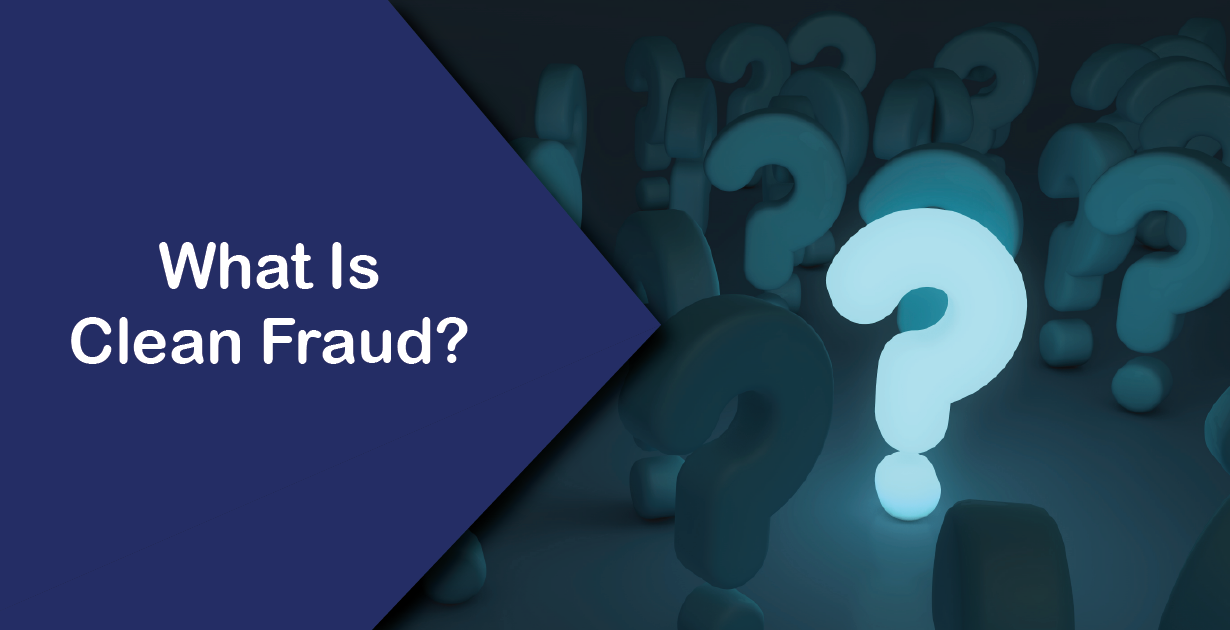
Fraud comes in many shapes and disguises. Over time it slowly but surely takes its toll on a merchant. When he discovers he has been victimized, the merchant is left with a long list of questions about how and why it happened. What’s confounding is that fraud is not simple and straight-forward – when done expertly it is subtle, savvy, and debilitating.
Clean fraud is so successful because it seems to sneak up on merchants, cloaked in any number of forms including friendly fraud, first-party fraud, and fraud by false claim. What makes clean fraud different is the way thieves use real customer data and identities to commit the crime. Most merchants are aware of the threats that come with stolen identities, fake credit cards, and security breaches, responding with multi-layered solutions designed specifically to stop this kind of fraud.
What makes clean fraud so difficult to detect is that it uses real data to commit fraud. Friendly fraud, first-party fraud, and fraud by false claim do not hide behind fake identities or stolen data. The success of clean fraud relies on the rules systems and checks and balances inherent in fraud detection solutions to detect fake or questionable data. Real data slides through, paving the way for the criminal activity. Yes, it is disconcerting – but the good news is that just like everything in payments and fraud, knowledge is power.
What Is Friendly Fraud?
One of the biggest challenges for merchants is understanding and preventing friendly fraud. The fact is that there is nothing friendly about it, because the fraudster makes claims that appear believable and honest but often are not. The existing merchant-cardholder relationship can make friendly fraud hard to identify and even harder to defend against in a chargeback representment case.
There are five key types of friendly fraud that must be on a merchant’s radar:
- Item wasn’t delivered. The cardholder claims the item didn’t arrive when in fact it was received.
- Item purchased doesn’t match the online description. The cardholder claims the item on the website is different than the description and wants a refund.
- Item returned but the refund wasn’t processed. The cardholder attempts to receive two refunds for one returned item.
- Cancelled the order but still received the item. The cardholder claims the order was cancelled but received the item, hoping they can keep the merchandise and receive a refund.
- Doesn’t remember making the purchase. The cardholder claims they didn’t make the purchase and their credit card must have been violated.
Preventing friendly fraud requires an expert customer service team, a payments solution designed to provide key confirmation and authorization messages, and best business practices in place including tracking numbers, clear online descriptions, and fully detailed refund/return policies.
What Is First-Party Fraud?
First-party fraud is one of the most prevalent but overlooked types of fraud plaguing merchants and issuers.
First-party fraud happens when the criminal applies for and uses a credit card with no intention to pay for the purchases. Because real identities and easy to validate information (addresses, phones numbers, email address, credit history) are used to verify the legitimacy of the credit card applicant, it’s difficult to distinguish a new, legitimate customer from a potential first-party fraud risk.
The primary victim of first-party fraud is the issuer, but the merchant doesn’t escape unscathed. The trickle-down effects of the credit loss include higher issuer fees, tighter and more restrictive credit card monitoring programs, and great scrutiny of merchant reliability.
What Is Fraud by False Claim?
Similar to friendly fraud, the cardholder takes advantage of the chargeback process to mask their fraud claim. Typically, fraud by false claim occurs when the cardholder stops a recurring purchase, claims they don’t remember the purchase, or claims buyer’s remorse.
By taking advantage of the inherent problems in the chargeback process, criminals understand that most merchants and issuers don’t have the resources or expertise to identify fraud by false claim easily. Because the chargeback reason is wholly believable, fraudsters can sneak through undetected. Often criminals target merchants who have unclear refund/return policies, out-of-date website information, or lack a strong customer service team.
How to Detect and Prevent Clean Fraud
There are no shortcuts or quick-fix solutions that will prevent clean fraud. It requires a multi-layered fraud prevention solution that uses best-in-class technology, including data analysis, artificial intelligence, IP analysis, biometrics, and more. It’s not enough to know that clean fraud is happening. It takes knowing how clean fraud happens, why it happens, and in anticipating the next incarnation of clean fraud – this is the only way to detect and prevent clean fraud.
You can contact us to learn how our payment solutions, specifically Order Insight and CDRN which can keep you on the cutting-edge of fraud prevention and detection.